This is more than just a glossary of brewing industry terminology, it’s an effective troubleshooting guide for understanding and resolving common brewing issues. Here you’ll find key information to help you overcome undesired results such as off-flavors, excessive levels of diacetyl, cell death, abnormal fermentation and more. Use the interactive glossary of brewing terminology as your go-to troubleshooting resource.
Glossary
A
FACTS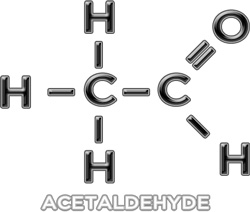
- high flavor and staling potential
- formed by yeast in the glycolytic pathway
- reduced during conditioning
CAUSES
- over-aeration
- deficiency of zinc
- deficiency of vitamins
EFFECTS
- responsible for “green” flavor in fresh beer
FACTS
- responsible for lowering pH during fermentation
EXAMPLES
- acetic (vinegar)
- butyric, isobutyric (butter)
- capric, caproic, caprylic (soap, sweat, goat)
- citric (tart)
- formic
- lactic
- malic
- oxalic
- oleic, linoleic
- propionic
- pyruvic
- valeric
CAUSES
- wort trub
- hop-staling
- by-products of yeast carbohydrate metabolism
EFFECTS
- some end as fatty acids responsible for off-flavors
% ALCOHOL BY WEIGHT
- 42 (°P original gravity – °P final gravity)
% ALCOHOL BY VOLUME
- (alcohol by weight x specific gravity of beer) / 0.791
FACTS
- high flavor and staling potential
EXAMPLES
- trans-2-nonenal
- furfural
CAUSES
- formed in Browning reactions during malting and mashing
- can increase or decrease during fermentation
EFFECTS
- responsible for “stale”, “paper” and “cardboard” flavors
EXPECTED VALUES
- dark ale = 68-75%
- lager = 78-86%
- pilsner = 80-85%
- light = 100%
% APPARENT ATTENUATION
- °Plato of original wort – °Plato of final wort / °Plato of original wort
FACTS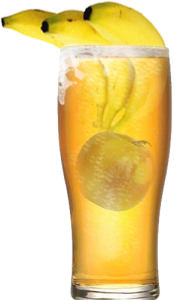
- condensation product of an alcohol and an acid
EXAMPLES
- isoamyl acetate (banana)
- ethyl acetate (apple)
CAUSES
- produced during yeast lipid synthesis
- yeast strains differ in their production
- high pitch rate – low levels
- high fermentation temperature – high levels
- high aeration – low levels
- high gravity – low levels
- high pressure – low levels
- high fatty acid content – low levels
EFFECTS
- “fruit” flavors
B
FACTS
- produced by all yeasts and some bacteria during amino acid synthesis
- reduced to a less-flavorful compound (2,3-butanediol) by yeast during conditioning

CAUSES OF HIGH LEVELS
- underpitching
- highly-flocculant yeast strain
- inadequate diacetyl rest
- bacterial contamination
- high petite-mutant population
EFFECTS OF HIGH LEVELS
- “butter” flavor
- slick mouth-feel
FACTS
- condensation product of an alcohol and an acid
EXAMPLES
- isoamyl acetate (banana)
- ethyl acetate (apple)
CAUSES
- produced during yeast lipid synthesis
- yeast strains differ in their production
- high pitch rate – low levels
- high fermentation temperature – high levels
- high aeration – low levels
- high gravity – low levels
- high pressure – low levels
- high fatty acid content – low levels
EFFECTS
- “fruit” flavors
FACTS
- sugars and amino acids react during kilning and boiling to yield pigments
- also known as the Maillard reaction
C
FACTS
- utilization is a function of yeast genetics
- glucose inhibits the transport of maltose and maltotriose in lager yeasts
SUGARS IN ORDER OF YEAST PREFERENCE
- glucose (diffuses through cell wall)
- fructose (diffuses through cell wall)
- sucrose (converted to glucose and fructose by invertase in cell wall)
- maltose, maltotriose (transported through cell wall, then converted to glucose)
FACTS
- passes through yeast cell wall in solution, not as a gas
- forms bubbles at nucleation sites such as trub particles and cell-wall exteriors
- removes volatile sulfur compounds as bubbles rise to surface
- can be present in super-saturated levels at fermentor bottom
CAUSES OF HIGH WORT LEVELS
- too little trub in wort
- fermentor is under pressure
EFFECTS OF HIGH WORT LEVELS
- decreases ester production
- inhibits yeast growth
- slows rate of fermentation
FACTS
- 40-60 million cell/ml needed in suspension for proper effect
D
FACTS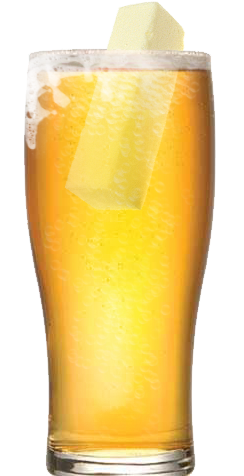
- produced by all yeasts and some bacteria during amino acid synthesis
- reduced to a less-flavorful compound (2,3-butanediol) by yeast during conditioning
CAUSES OF HIGH LEVELS
- underpitching
- highly-flocculant yeast strain
- inadequate diacetyl rest
- bacterial contamination
- high petite-mutant population
EFFECTS OF HIGH LEVELS
- “butter” flavor
- slick mouth-feel
CAUSES IN WORT
- excessive build-up of copper
- over-sparging of mash, leaching toxic polyphenol-protein complexes into wort
- high nitrite levels in brewing water (>25ppm)
- insufficient wort aeration
- high levels of unsaturated fatty acids
CAUSES IN SLURRY
- over-aeration of slurry with pure oxygen
- high temperature, insufficient nutrients
E
FACTS
- condensation product of an alcohol and an acid
EXAMPLES
- isoamyl acetate (banana)
- ethyl acetate (apple)
CAUSES
- produced during yeast lipid synthesis
- yeast strains differ in their production
- high pitch rate – low levels
- high fermentation temperature – high levels
- high aeration – low levels
- high gravity – low levels
- high pressure – low levels
- high fatty acid content – low levels
EFFECTS
- “fruit” flavors
F
SYMPTOMS
- high carbon dioxide evolution
CAUSES
- large amounts of trub
- wort is too chilled
- uneven temperature profile
- uneven yeast distribution
- over-modified malt
- build-up of beerstone
- excessive wort maltose
- unusual characteristics of yeast
SOLUTIONS
- break up yeast by aerating
- remove more trub from wort
SYMPTOMS
- slow, bubbling fermentation, usually appearing after krausen stage
CAUSES
- degenerated or autolyzed yeast
- poor trub elimination
- sudden temperature increase
- poor cellar ventilation
- presence of nitrites
- highly kilned malts
SOLUTIONS
- pump wort into another fermentor
- add vigorous, roused yeast
SYMPTOMS
- slow or no fermentation
CAUSES
- insufficient wort aeration
- lack of fermentable sugars in wort
- wort pH too high (over 5.5)
- fermentor and wort too cold, causing yeast to flocculate
- yeast lacks enzymes need to ferment maltotriose
- weak or degenerated yeast
- inadequately cured malt
- antifoam agents or trub clogging yeast membrane
- extensively demineralized water
- extremely soft water
- water high in carbonate hardness
- high nitrate level (>25ppm)
- high copper content
SOLUTIONS
- add vigorous, roused yeast
- pump wort into another fermentor
- analyze to determine whether yeast is capable of fermenting wort sugar-profile
ADVANTAGES
- lower energy costs
- maximal use of equipment and space
- improved physical stability from better precipitation of chill haze
- improved flavor stability
DISADVANTAGES
- wort- and hop- efficiencies can be reduced
- increased yeast stress
- 50% or more yeast is needed
- number of yeast generations is reduced
- oxygen levels as high as 10-12pmm are needed
- increased cost of losses
- longer fermentation times
- decreased foam stability
- higher final pH
CAUSES IN WORT
- pH above 5.7
- temperature too close to low end of yeast’s fermentation range
- inadequate aeration (empty bottle/stuck regulator)
- insufficient nutrients (especially zinc)
- contamination
CAUSES IN YEAST SLURRY
- too warm storage conditions (over 34°F/1°C)
- too long storage time (greater than 48 hours if unfed)
- poor viability (less than 95%)
- contamination
GUIDELINES
- warm slurry to upper end of yeast’s fermentation range
- aerate if specific gravity has dropped less than 30% of expected total
- add zinc to wort
- add fresh, healthy yeast
FACTS
- by-product of protein synthesis from keto-acids
- have longer carbon-chain length than ethanol
EXAMPLES
- n-propanol (solvent)
- iso-butanol (solvent)
- 2-phenyl ethanol (medicinal)
- 2-methyl-1-butanol (aromatic)
- 3-methyl-1-butanol (spice)
CAUSES
- affected by wort amino acid composition
- high pitch rate – low levels
- high fermentation temperature – high levels
- high aeration – high levels
- high gravity – low levels
- high pressure – low levels
- high fatty acid content – low levels
EFFECTS
- fullness of flavor at low levels
- unpleasant at high levels
H
SYMPTOMS
- little or no foam though carbonation levels are adequate
CAUSES
- proteases released by autolyzing yeast
- unclean equipment
SOLUTIONS
- do not store yeast under finished beer
- clean and degrease equipment
- check for leaking pump-lubricant
FACTS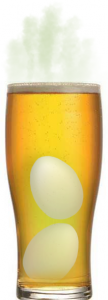
- normally purged during fermentation by carbon dioxide
CAUSES
- reduced from sulfite by yeast
- made by yeast from sulfur-containing amino acids
- produced most during budding
- degenerated pitching yeast
- some wort-spoiling bacteria
EFFECTS
- “rotten-egg” odor
L
LAG PHASE
- changes in pressure, temperature and nutrients
- biosynthesis of enzymes needed for metabolism
- oxygen rapidly removed from wort for sterol and fatty acid synthesis
LOGRITHMIC PHASE
- fast yeast reproduction
- uptake of nutrients and sugars
- heat is generated
- volatiles are driven off
DECLINING PHASE
- increase in acidity, alcohol and carbon dioxide
- utilization of glycogen and sterol reserves
- reproduction ceases
- flocculation
M
FACTS
- sugars and amino acids react during kilning and boiling to yield pigments also known as the Maillard reaction.
N
FACTS
- nitrogen content decreases 30% during fermentation
- large concentration of nitrogen is found in wort amino acids
- yeast assimilates nitrogen from amino acids and small proteins
- yeast will manufacture missing amino acids, yielding off-flavors, like phenylethanol (rose)
AMINO ACIDS IN ORDER OF YEAST PREFERENCE
- threonine
- methionine
- isoleucine, leucine
- valine
- tyrosine
- tryptophan
- phenylalanine
O
TEMPERATURE, °C : SATURATION, mg/l
- 5 : 10
- 6 : 9
- 10 : 8
- 15 : 7
FACTS
- more soluble at lower temperatures
- usually completely taken up within 2 hours of pitch
CAUSES
- yeast enzymes require oxygen to synthesize membrane building-blocks
EFFECTS
- deficiency restricts yeast growth
- deficiency reduces yeast viability
- deficiency impedes complete fermentation
- deficiency alters beer flavor
P
FACTS
- occurs very rapidly over the first 48 hours of fermentation
- usually spans at least 1 pH unit over fermentation period
- optimal pH for yeast is pH 4.0
CAUSES
- affected by any factor that affects yeast growth
- due 10% to formation of carbon dioxide
- due 20% to formation of organic acids (lactic, succinic, oxalic)
- due 40% to absorption of alkaline substances such as phosphates and amino acids
EFFECTS
- extreme drop produces a less mellow, more astringent, drier-tasting beer
EXAMPLES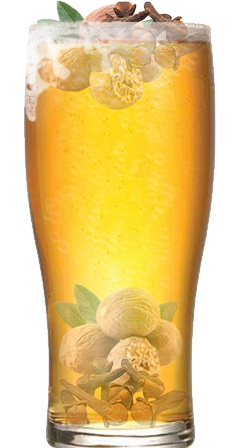
- 4-vinyl-guiacol (clove)
- 4-ethyl-guiacol (nutmeg)
CAUSES
- malt and hops
- weiss yeast conversion of ferulic acid
EFFECTS
- “spice” flavors
PRESSURE, HIGH (high fermentation pressure):
CAUSES
- exceedingly tall fermentors
- obstructed blow-off
EFFECTS
- increases FAN in resulting beer
- increases vicinal diketones and diacetyl
- increases acetaldehyde
- decreases yeast growth
- decreases ethyl acetate
- decreases fusel alcohols
S
FACTS
- specific gravity uses pure water as a reference
- wort contains fermentable sugars which raise the specific gravity
CAUSES OF DROP IN
- yeast metabolize sugars
- soluble substances are used by yeast
- alcohol, which is less dense than water, increases
- carbon dioxide is produced
FACTS
- very low flavor threshold
EXAMPLES
- DMS
- hydrogen sulfide
- sulfite
- thiols
CAUSES
- malt, hops and yeast metabolism
- stressed or autolyzing yeast
EFFECTS
- low levels impart fullness
- high levels are very unpleasant
FACTS
- an intermediate in the synthesis of sulfur-containing amino acids
CAUSES
- derived from wort sulfate
- reduced to sulfite by yeast
- factors which retard yeast growth will increase levels
EFFECTS
- complexing with acetaldehyde leads to early staling
T
FACTS
- fermentation is an exothermic, biochemical reaction
- every kg of extract fermented produces 140kcal of heat
CAUSES OF LOW TEMPERATURES
- over-zealous wort-cooling
- cold ambient temperatures
EFFECTS OF LOW TEMPERATURES
- increases fermentation time
- encourages yeast to flocculate
- ale yeasts produce more sulfur compounds
CAUSES OF HIGH TEMPERATURES
- inefficient or malfunctioning glycol system
EFFECTS OF HIGH TEMPERATURES
- decreases fermentation time
- decreases acetaldehyde
- increases fermentation by-products
- increases ethyl acetate
- increases fusel alcohols
ALES
- between 15-20°C / 60-70°F
LAGERS
- between 8-13°C / 45-55°F
FACTS
- levels may decrease during storage
EXAMPLES
- methanethiol
- methylmercaptan
- methylthioacetate
CAUSES
- related to yeast amino acid synthesis
EFFECTS
- “young” flavor and aroma
- “light-struck” character if exposed to ultraviolet light
W
FACTS
- precipitates chill haze proteins
- encourages yeast flocculation
GUIDELINES
- do not exceed drop rate of 20°F / 10°C per hour
Y
LAG PHASE
- changes in pressure, temperature and nutrients
- biosynthesis of enzymes needed for metabolism
- oxygen rapidly removed from wort for sterol and fatty acid synthesis
LOGRITHMIC PHASE
- fast yeast reproduction
- uptake of nutrients and sugars
- heat is generated
- volatiles are driven off
DECLINING PHASE
- increase in acidity, alcohol and carbon dioxide
- utilization of glycogen and sterol reserves
- reproduction ceases
- flocculation
Z
FACTS
- optimal wort level is 0.25ppm
EFFECTS
- high levels lead to higher ester production
- high levels encourage yeast flocculation

